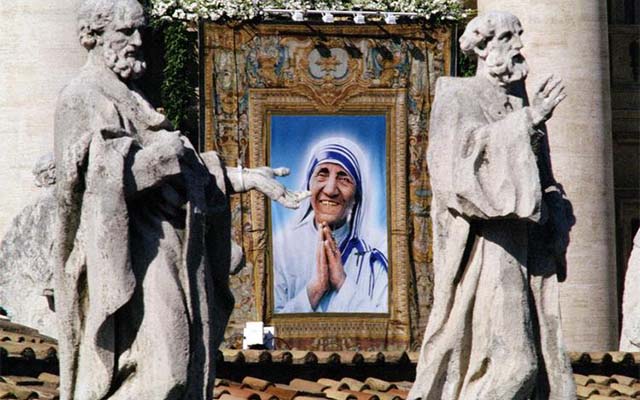Mother Teresa becomes saint, controversies linger


A statue of Mother Teresa stands at the Shishu Bhawan children’s home in Kolkata, a reminder of her years of service there. – (National Geographic)
Jackie Snow Correspondent
On September 4, Mother Teresa was elevated to sainthood when Pope Francis canonised her at the Vatican. The late nun, already called Saint of the Gutters and who won the Nobel Prize in 1979, is widely known for her decades spent caring for the poor and sick in Kolkata, India.
Many Catholics and non-Catholics alike admire her, but her canonisation is not without controversy.
Millions, if not billions, of people around the world have long loved the woman who has become a symbol for service to the least fortunate.
World leaders received and honoured her, including Ronald Reagan, Indira Gandhi, Princess Diana, and the Dalai Lama. Mother Teresa received the Presidential Medal of Freedom and an honorary doctorate from the University of Cambridge.
President Bill Clinton made Mother Teresa an honorary American citizen in 1996, saying she had demonstrated “how we can make real our dreams for a just and good society.”
Born Agnes Gonxha Bojaxhiu in 1910, in what is now Macedonia, Mother Teresa joined the Loreto order of nuns in 1928. It was on a 1946 train trip through India when she was inspired to leave the Loreto order and found the Missionaries of Charity.

Around 300 000 people crowded St Peter’s Square when Pope John Paul II led a beatification of Mother Teresa in 2003, just 18 months after her death. – (National Geographic)
The order was established four years later and has since opened more than 130 houses around the world to provide care for the sick and dying.
Missionaries of Charity nuns must adhere to the traditional vows of chastity, poverty, and obedience, as well as a fourth vow, to give “wholehearted free service to the poorest of the poor.” Mother Teresa worked as head of Missionaries of Charity until six months before her death in 1997 at 86.
The late Christopher Hitchens was one of Mother Teresa’s most outspoken critics. In his 2012 book The Missionary Position: Mother Teresa in Theory and Practice, Hitchens wrote that some doctors who visited her missions alleged that patients experienced a shortage of care in unhygienic conditions, with inadequate food and no painkillers. Mother Teresa, on the other hand, went to costly American facilities when she needed her own medical treatment.
Hitchens writes that Mother Teresa accepted a donation of more than a million dollars from financier Charles Keating, who later went to prison for defrauding investors. Mother Teresa wrote to the court asking clemency for Keating without explaining their relationship. She took money from and praised right-wing dictator Jean-Claude Duvalier, who later was accused of allowing the torture and murder of thousands of Haitians during his regime.
Hitchens quotes from an unpublished book by Susan Shields, a former nun from the Missionaries of Charity, who claims Mother Teresa taught nuns to secretly baptise the dying. After asking the person if they wanted a “ticket to heaven” the nun would then; “Pretend she was just cooling the person’s forehead with a wet cloth, while in fact she was baptising him, saying quietly the necessary words.”
The canonisation process
The canonisation process has changed through the centuries. The first people honoured as saints were martyrs who died for their faith.
The pope wasn’t even always involved in making saints in the early days of the church. In 1234, the right to canonise was officially reserved for the papacy. Until Pope John Paul II, about 300 saints were made.
Under Pope John Paul II, the process to canonise was simplified and the number of saints increased dramatically. He canonised 482 saints during his 26-year reign from 1978 to 2005. He beatified 1,327 people, including Mother Teresa.
It is usually a slow process. Since 1588, when the Catholic Church created an office called the Congregation for the Causes of Saints, the average time between the death of an eventual saint and canonisation is 181 years.
Not so for Mother Teresa. Within 18 months of her death, John Paul II waived the usual five-year waiting period and allowed the opening of the process to declare her sainthood.
“By Roman standards, it’s lightning speed,” said Lawrence Cunningham, a retired religion professor from Notre Dame.
The Congregation for the Causes of Saints oversees the canonisation process. Once a cause has begun, the individual can be called a Servant of God. A postulator, the person assigned to present the cause, is assigned and collects public and private writings, interviews people who knew the candidate, and researches the person’s life. The postulator then produces a paper, called a position, which can run for thousands of pages.
“They tend to read like biographies,” Cunningham said.
When the position is finished, it’s presented to a theological commission put together by the Congregation for the Causes of Saints that will vote on whether or not the cause can proceed. The commission then appeals to the pope to offer a Decree of Heroic Virtues for the person. The sainthood candidate is then known as a Venerable Servant of God.
To be beatified and then canonised, two miracles, almost always medical in nature, need to be confirmed.
The consulta medica, a group of doctors paid a nominal fee by the church, investigate to determine if there is a scientific explanation for a miracle.
For Mother Teresa, her first miracle involved an Indian woman who claimed that her abdomen tumours healed in 1998 after she touched herself with a locket containing the nun’s picture. For her second miracle, a Brazilian man was said to have been cured of brain tumours in 2008 after he prayed to Mother Teresa.
But at least one of those miracles has been called into question. Researchers at the University of Montreal and the University of Ottawa concluded in a 2013 paper that her first miracle had a medical explanation. Published in Religieuses, a French-language journal of studies in religion and sciences, the researchers found that the doctors and husband of the woman believed that she was healed by a drug treatment.
“It’s more about faith and image than real science,” said Genevieve Chenard, one of the paper’s authors, from the University of Montreal.
Mother Teresa’s canonisation
After confirming the miracles, canonisation can go forth. Churches around where the saint is from will often have special masses, but for the Vatican the pope simply offers a public statement that the person is on the official list maintained by the Catholic Church of those that could be venerated publicly.
The public statement is still a big deal to many. High-ranking members of the Missionaries of Charity will go to Rome for the canonisation, which falls one day before the 19th anniversary of her death, bringing a relic of Mother Teresa’s blood.
According to the Times of India, the two people said to be healed through the miracles that confirmed her sainthood are expected to attend.
Thousands of people from around the world will also be there. For her beatification in 2003, more than 300 000 pilgrims went to Rome.
Her canonisation falls during the Catholic Church’s Extraordinary Jubilee of Mercy. Pope Francis called for this jubilee, or holy year, out of the ordinary cycle of jubilees, which typically happen every 25 years.
The pope said the world is particularly in need of mercy at this time.
While the church has not said the canonisation is specifically linked to the Extraordinary Jubilee, Mother Teresa’s record of working with the “poorest of the poor” fits into the theme of mercy. Despite her flaws, Cunningham, the retired religion professor, said she inspired millions and did work few are willing to do.
“To do it for 30, 40 years, day in and day out, requires a certain heroism in one’s life,” Cunningham said. “The canonisation underscores the teaching about mercy.” – National Geographic.









Comments